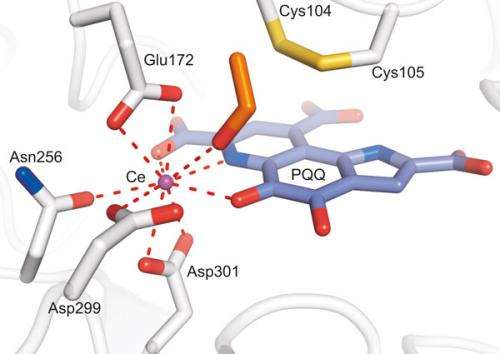Methane-decomposing bacteria from hot springs need the valuable metals to produce energy

Rare earths are among the most precious raw materials of all. These metals are used in mobile telephones, display screens and computers. And they are apparently indispensable for some organisms as well. A team of researchers, including scientists from the Max Planck Institute for Medical Research in Heidelberg, has discovered a bacterium which needs rare earths to grow - in a hot spring. Methylacidiphilum fumariolicum requires lanthanum, cerium, praseodymium or neodymium as co-factor for the enzyme methanol dehydrogenase, with which the microbes produce their energy. The use of rare earths is possibly more widespread among bacteria than previously thought.
In reality, the 17 metals that belong to the group of rare earths are not rare at all. The Earth's crust contains larger quantities of rare earths than of gold or platinum, for example. The problem is that the elements have a relatively even distribution, so that mining is economical in only a few places.
In living organisms, the rare earths really are rare, on the other hand. As they dissolve hardly at all in water, most organisms cannot use them for their metabolism. This makes their discovery in a mudpot of volcanic origin in the Solfatara crater in Italy all the more surprising. Microbiologists from the Radboud University in Nijmegen, the Netherlands, have found a microbe which cannot live without some of the rare earths.
Methylacidiphilum fumariolicum belongs to a group of bacteria which have chosen an extremely inhospitable habitat: They thrive best at a pH value of between 2 and 5 and temperatures of between 50 and 60 degrees - conditions which are lethal for other organisms. Methylacidiphilum even tolerates pH values below 1, which corresponds to concentrated sulphuric acid.
The microbes produce their energy from methane. They have a special enzyme, methanol dehydrogenase, which processes the methanol produced in the decomposition of methane with the aid of metal co-factors. Most of these bacteria use calcium for this process.
In the course of their investigations, the Nijmegen researchers noticed that Methylacidiphilum thrives only with original water from the mudpot. None of the trace elements which the researchers added to the Petri dishes encouraged the bacteria to grow. An analysis of the water showed that it contained concentrations of rare earths that were one hundred to one thousand times higher than normal.
Thomas Barends and Andreas Dietl from the Max Planck Institute for Medical Research investigated the three-dimensional structure of methanol dehydrogenase. They thereby noticed that Methylacidiphilum fumariolicum had inserted not calcium, but an atom of a different metal in its methanol dehydrogenase.
"Suddenly, everything fit together," explains Thomas Barends. "We were able to show that this mysterious atom must be a rare earth. This is the first time ever that rare earths have been found to have such a biological function." Methylacidiphilum uses the rare earths lanthanum, cerium, praseodymium and neodymium in its methanol dehydrogenase instead of calcium. The bacterium needs them to produce energy from methane.
The rare earths have a slightly larger ion radius than calcium, but can still replace it as a co-factor of enzymes. "Individual amino acids have been exchanged in the amino acid chain of the methanol dehydrogenase of the bacterium. This creates more room for the metals," says Barends. In addition, Methylacidiphilum digests a larger quantity of rare earths than it needs to survive. It is therefore possible that it stores the metals in the cell.
Genome and proteome analyses suggest that the Methylacidiphilum version of methanol dehydrogenase is widespread among bacteria from coastal waters. Scientists have also discovered methane-exploiting bacteria equipped with this on the leaf surface of plants. Plants can enrich rare earths and thus safeguard the supply for the bacteria. "These bacteria are possibly present anywhere there is a sufficient supply of sand, as sand is an almost inexhaustible source of rare earths," says Barends.
More information: Arjan Pol, Thomas R. M. Barends, Andreas Dietl, Ahmad F. Khadem, Jelle Eygensteyn, Mike S. M. Jetten, and Huub J. M. Op den Camp, Rare earth metals are essential for methanotrophic life in volcanic mudpots, Environmental Microbiology, October 2013, DOI: 10.1111/1462-2920.12249
Journal information: Environmental Microbiology
Provided by Max Planck Society















